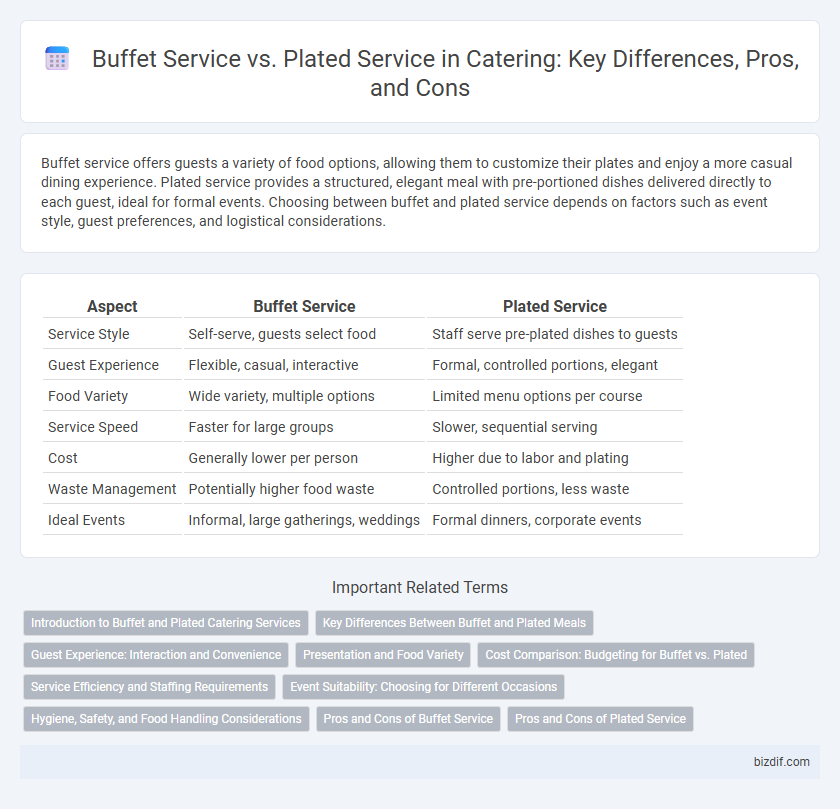Buffet service offers guests a variety of food options, allowing them to customize their plates and enjoy a more casual dining experience. Plated service provides a structured, elegant meal with pre-portioned dishes delivered directly to each guest, ideal for formal events. Choosing between buffet and plated service depends on factors such as event style, guest preferences, and logistical considerations.
Table of Comparison
| Aspect | Buffet Service | Plated Service |
|---|---|---|
| Service Style | Self-serve, guests select food | Staff serve pre-plated dishes to guests |
| Guest Experience | Flexible, casual, interactive | Formal, controlled portions, elegant |
| Food Variety | Wide variety, multiple options | Limited menu options per course |
| Service Speed | Faster for large groups | Slower, sequential serving |
| Cost | Generally lower per person | Higher due to labor and plating |
| Waste Management | Potentially higher food waste | Controlled portions, less waste |
| Ideal Events | Informal, large gatherings, weddings | Formal dinners, corporate events |
Introduction to Buffet and Plated Catering Services
Buffet service offers a self-serve dining experience where guests select food from a variety of dishes displayed on a table, promoting variety and convenience for large gatherings. Plated service involves individually prepared meals presented to guests at their seats, emphasizing elegance and portion control. Each catering style suits different event types, with buffet ideal for casual or diverse menus and plated service preferred for formal occasions.
Key Differences Between Buffet and Plated Meals
Buffet service offers guests a variety of food options in a self-serve format, promoting flexibility and social interaction, while plated service delivers pre-selected meals directly to each guest, ensuring portion control and consistent presentation. Buffets accommodate diverse dietary preferences and encourage mingling, whereas plated service provides a more formal dining experience with controlled timing and refined ambiance. The choice between buffet and plated meals impacts event flow, guest experience, and catering logistics.
Guest Experience: Interaction and Convenience
Buffet service offers guests the freedom to choose from a variety of dishes at their own pace, enhancing interaction and socializing opportunities during the event. Plated service delivers convenience through personalized portions, ensuring a seamless and elegant dining experience without waiting in line. Both styles cater to different guest preferences, balancing customization with efficiency for optimal satisfaction.
Presentation and Food Variety
Buffet service offers a visually appealing presentation with a wide array of food options displayed simultaneously, encouraging guests to customize their plates according to personal preferences. Plated service delivers an elegant and refined presentation, often featuring meticulously arranged dishes that highlight the chef's artistry and controlled portion sizes. While buffets maximize variety and self-selection, plated service emphasizes sophistication and consistent quality for each guest.
Cost Comparison: Budgeting for Buffet vs. Plated
Buffet service generally offers a more cost-effective catering option due to lower labor expenses and bulk food preparation, making it ideal for larger events. Plated service typically incurs higher costs from additional staff required for individualized meal delivery and more intricate presentation. Budgeting should account for guest count, service style, and menu complexity to determine the optimal balance between cost and experience.
Service Efficiency and Staffing Requirements
Buffet service enhances efficiency by allowing multiple guests to serve themselves simultaneously, reducing the need for extensive staffing and speeding up meal distribution. Plated service requires a higher staff-to-guest ratio to ensure timely delivery and personalized presentation, increasing labor costs and complexity. Choosing between buffet and plated service depends on event size, desired guest experience, and available staffing resources.
Event Suitability: Choosing for Different Occasions
Buffet service offers flexibility and variety, making it ideal for casual events, large gatherings, and settings where guests prefer a self-paced dining experience. Plated service provides a formal and structured atmosphere suited for weddings, corporate dinners, and elegant occasions where presentation and personalized service are prioritized. Event organizers should consider guest interaction, space, and flow when deciding between buffet and plated service options.
Hygiene, Safety, and Food Handling Considerations
Buffet service requires strict hygiene protocols to prevent cross-contamination, including frequent cleaning of serving utensils and protective sneeze guards to minimize direct contact with food. Plated service offers enhanced food safety by minimizing guest interaction with dishes, reducing the risk of contamination during handling and serving. Proper staff training in food handling, temperature control, and sanitation practices is essential for both buffet and plated services to ensure overall food safety and hygiene compliance.
Pros and Cons of Buffet Service
Buffet service offers guests a wide variety of food choices and allows for self-paced dining, enhancing flexibility and social interaction during events. It typically reduces staffing costs and speeds up meal service but may lead to food waste and less formal presentation compared to plated service. Temperature control and portion consistency can be challenging, impacting overall guest satisfaction in buffet setups.
Pros and Cons of Plated Service
Plated service offers a formal dining experience with precise portion control and elegant presentation, enhancing guest satisfaction at upscale events. It requires more staff and time for serving each course, potentially increasing costs and slowing service speed. Limited guest choice and less opportunity for customization can affect comfort for diverse dietary preferences.
Buffet Service vs Plated Service Infographic

 bizdif.com
bizdif.com